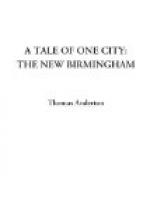The buildings in this street have, as I have said, the charm of diversity, and that, I suppose, is something to the good. Regent Street, London, is a fine thoroughfare, but it will probably be admitted that it is anything but unmonotonous in appearance or lovely to look upon from an architectural point of view. The buildings in our grand new street may not be beyond criticism, but there are no long lines of buildings of the same heavy dull pattern from end to end. This arises from the fact that the land has not been let in big patches to capitalists or builders who might have erected a series of shops of one uniform pattern, but has been leased to tradesmen and others who have taken a few yards of land, on which they have built premises suited to their requirements, and in accordance with their aim, tastes, or the bent and ability of their architects. Hence the variety, charming or otherwise according to the taste and eye of the spectator. Anyway, we have in Birmingham a fine broad street which will, perhaps, compare favourably with any thoroughfare in any other British city, with the exception of Princes Street, Edinburgh. In the way of splendid streets the Scotch capital must be allowed to take the plum.
XI.
The fourth estate.
I cannot say how it may have been in other large cities and towns, but certainly the newspaper mortality in Birmingham during the past half century has been quite distressing. I think that without difficulty I could reckon up from twenty-five to thirty papers and journals that have been first published and last published in the period named. I do not propose to say much or to give a list of the dear departed. They were born, they struggled for existence, and they died in the effort. That is all that need be said of most of them.
There is, however, one defunct paper to which I must make a short reference, partly because I remember something about its birth and death. I refer to the Birmingham Daily Press, which first appeared in May, 1855. If my memory serves me, the Act of Parliament repealing the newspaper duty had not passed and become law when the Birmingham Daily Press appeared. Its first issues were, I believe, marked “specimen” copies, which would seem to show that the new penny paper was really published in anticipation of the passing of the Act.
Anyway, the Birmingham Daily Press appeared in the year mentioned, and considering that it was altogether a new venture, and that much had to be learned by experience, it was a highly creditable production. It soon made its mark, too, and became popular and largely read. And no wonder. It supplied a real want. Its contents were readable and useful, and its pages contained smart and attractive articles and papers that excited notice and were much appreciated. Mr. George Dawson was connected with the paper. Mr. William Harris was editor, or co-editor, of it, and on its staff and among its contributors were some sharp and able writers.




